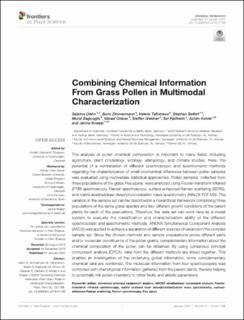| dc.contributor.author | Diehn, Sabrina | |
| dc.contributor.author | Zimmermann, Boris | |
| dc.contributor.author | Tafintseva, Valeria | |
| dc.contributor.author | Seifert, Stephan | |
| dc.contributor.author | Bağcıoğlu, Murat | |
| dc.contributor.author | Ohlson, Mikael | |
| dc.contributor.author | Weidner, Steffen | |
| dc.contributor.author | Fjellheim, Siri | |
| dc.contributor.author | Kohler, Achim | |
| dc.contributor.author | Kneipp, Janina | |
| dc.date.accessioned | 2020-11-17T14:21:38Z | |
| dc.date.available | 2020-11-17T14:21:38Z | |
| dc.date.created | 2020-07-27T11:38:15Z | |
| dc.date.issued | 2020 | |
| dc.identifier.citation | Frontiers in Plant Science. 2020,10,1788 | en_US |
| dc.identifier.issn | 1664-462X | |
| dc.identifier.uri | https://hdl.handle.net/11250/2688298 | |
| dc.description.abstract | The analysis of pollen chemical composition is important to many fields, including agriculture, plant physiology, ecology, allergology, and climate studies. Here, the potential of a combination of different spectroscopic and spectrometric methods regarding the characterization of small biochemical differences between pollen samples was evaluated using multivariate statistical approaches. Pollen samples, collected from three populations of the grass Poa alpina, were analyzed using Fourier-transform infrared (FTIR) spectroscopy, Raman spectroscopy, surface enhanced Raman scattering (SERS), and matrix assisted laser desorption/ionization mass spectrometry (MALDI-TOF MS). The variation in the sample set can be described in a hierarchical framework comprising three populations of the same grass species and four different growth conditions of the parent plants for each of the populations. Therefore, the data set can work here as a model system to evaluate the classification and characterization ability of the different spectroscopic and spectrometric methods. ANOVA Simultaneous Component Analysis (ASCA) was applied to achieve a separation of different sources of variance in the complex sample set. Since the chosen methods and sample preparations probe different parts and/or molecular constituents of the pollen grains, complementary information about the chemical composition of the pollen can be obtained. By using consensus principal component analysis (CPCA), data from the different methods are linked together. This enables an investigation of the underlying global information, since complementary chemical data are combined. The molecular information from four spectroscopies was combined with phenotypical information gathered from the parent plants, thereby helping to potentially link pollen chemistry to other biotic and abiotic parameters. | en_US |
| dc.language.iso | eng | en_US |
| dc.rights | Attribution-NonCommercial-NoDerivatives 4.0 Internasjonal | * |
| dc.rights.uri | http://creativecommons.org/licenses/by-nc-nd/4.0/deed.no | * |
| dc.subject | Fouriertransform infrared spectroscopy | en_US |
| dc.subject | Fouriertransform infrared spectroscopy | en_US |
| dc.subject | Consensus principal component analysis | en_US |
| dc.subject | Consensus principal component analysis | en_US |
| dc.subject | Pollen | en_US |
| dc.subject | Pollen | en_US |
| dc.title | Combining Chemical Information From Grass Pollen in Multimodal Characterization | en_US |
| dc.type | Peer reviewed | en_US |
| dc.type | Journal article | en_US |
| dc.description.version | publishedVersion | en_US |
| dc.source.pagenumber | 18 | en_US |
| dc.source.volume | 10 | en_US |
| dc.source.journal | Frontiers in Plant Science | en_US |
| dc.identifier.doi | 10.3389/fpls.2019.01788 | |
| dc.identifier.cristin | 1820588 | |
| dc.relation.project | EC/FP7/328289 | en_US |
| dc.relation.project | ERC-European Research Council: 259432 | en_US |
| dc.source.articlenumber | 1788 | en_US |
| cristin.ispublished | true | |
| cristin.fulltext | original | |
| cristin.qualitycode | 2 | |

